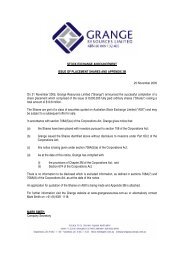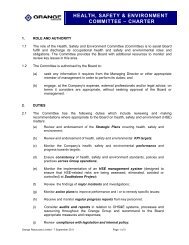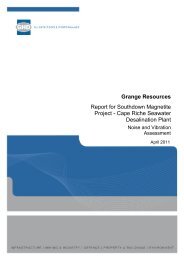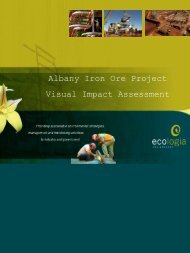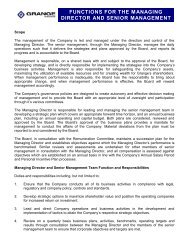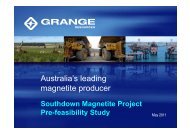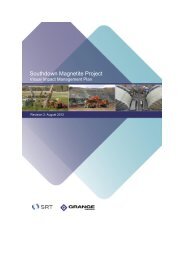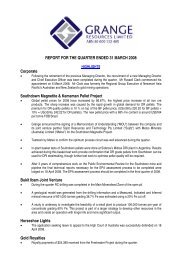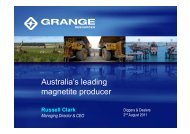2011 Annual Report (3 April 2012) - Grange Resources
2011 Annual Report (3 April 2012) - Grange Resources
2011 Annual Report (3 April 2012) - Grange Resources
Create successful ePaper yourself
Turn your PDF publications into a flip-book with our unique Google optimized e-Paper software.
<strong>2011</strong> ANNUAL REPORT<br />
55<br />
Deferred tax assets and liabilities are offset when there is a<br />
legally enforceable right to offset current tax assets and liabilities<br />
and when the deferred tax balances relate to the same taxation<br />
authority. Current tax assets and tax liabilities are offset where the<br />
entity has a legally enforceable right to offset and intends either to<br />
settle on a net basis, or to realise the asset and settle the liability<br />
simultaneously.<br />
<strong>Grange</strong> <strong>Resources</strong> Limited and its wholly-owned Australian<br />
controlled entities have implemented the tax consolidation<br />
legislation. On 6 January <strong>2011</strong>, the Group merged its two<br />
separate tax consolidated group’s and <strong>Grange</strong> <strong>Resources</strong><br />
Limited became the head entity of the merged tax consolidated<br />
group. As a consequence, <strong>Grange</strong> <strong>Resources</strong> Limited and its<br />
subsidiaries are taxed as a single entity and the deferred tax<br />
assets and liabilities of the Group are set off in the consolidated<br />
financial statements.<br />
(m) Goods and Services Tax (GST)<br />
Revenues, expenses and assets are recognised net of the<br />
amount of GST except:<br />
◆◆<br />
◆◆<br />
when GST incurred on a purchase of goods and services is<br />
not recoverable from the taxation authority, in which case the<br />
GST is recognised as part of the cost of acquisition of the<br />
asset or as part of the expense item as applicable; and<br />
receivables and payables, which are stated with the amount<br />
of GST included.<br />
The net amount of GST recoverable from, or payable to, the<br />
taxation authority is included as part of receivables or payables in<br />
the balance sheet.<br />
Cash flows are included in the Statement of Cash Flows on a<br />
gross basis and the GST component of cash flows arising from<br />
investing and financing activities, which is recoverable from, or<br />
payable to, the taxation authority, are presented as operating<br />
cash flows.<br />
Commitments and contingencies are presented net of the amount<br />
of GST recoverable from, or payable to, the taxation authority.<br />
(n) Property, plant and equipment<br />
Land and buildings and plant and equipment are measured<br />
at cost less, where applicable, any accumulated depreciation,<br />
amortisation or impairment in value. Cost includes expenditure<br />
that is directly attributable to the acquisition of the item. In the<br />
event that all or part of the purchase consideration is deferred,<br />
cost is determined by discounting the amounts payable in the<br />
future to their present value as at the date of acquisition.<br />
Subsequent costs are included in the asset’s carrying amount or<br />
recognised as a separate asset, as appropriate, only when it is<br />
probable that future economic benefits associated with the item<br />
will flow to the Group and the cost of the item can be measured<br />
reliably. The carrying amount of any component accounted for as<br />
a separate asset is derecognised when replaced. All other repairs<br />
and maintenance are charged to the income statement during the<br />
reporting period in which they are incurred.<br />
Land is not depreciated. Assets under construction are measured<br />
at cost and are not depreciated until they are ready and available<br />
for use. Depreciation on assets is calculated using either a<br />
straight-line or diminishing value method to allocate the cost,net<br />
of their residual values, over the estimated useful lives or the life<br />
of the mine, whichever is shorter. Leasehold improvements and<br />
certain leased plant and equipment are depreciated over the<br />
shorter lease term.<br />
Other non-mine plant and equipment typically has the following<br />
estimated useful lives:<br />
Buildings<br />
Plant and Equipment<br />
Computer Equipment<br />
10 years<br />
4 to 8 years<br />
3 to 5 years<br />
The assets residual values, useful lives and amortisation methods<br />
are reviewed and adjusted if appropriate, at each financial period<br />
end.<br />
An item of property, plant and equipment is derecognised upon<br />
disposal or when no further economic benefits are expected from<br />
its use or disposal.<br />
Any gain or loss arising on derecognition of the asset (calculated<br />
as the difference between the net disposal proceeds and the<br />
carrying amount of the asset) is included in the income statement<br />
in the period the asset is derecognised.<br />
(o) Exploration and evaluation<br />
Exploration and evaluation expenditure comprises costs which<br />
are directly attributable to:<br />
◆◆<br />
research and analysing exploration data<br />
◆◆<br />
◆◆<br />
◆◆<br />
conducting geological studies, exploratory drilling and<br />
sampling<br />
examining and testing extraction and treatment methods<br />
compiling pre-feasibility and definitive feasibility studies<br />
Exploration and evaluation expenditure also includes the costs<br />
incurred in acquiring rights, the entry premiums paid to gain<br />
access to areas of interest and amounts payable to third parties<br />
to acquire interests in existing projects.<br />
DirectorS’ <strong>Report</strong><br />
Financial Statements<br />
Shareholder information



